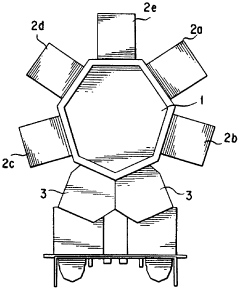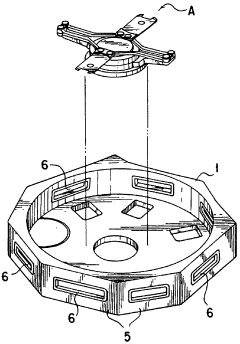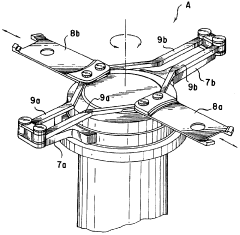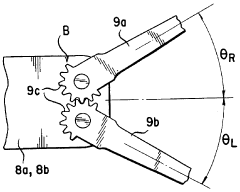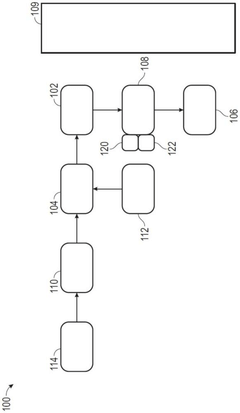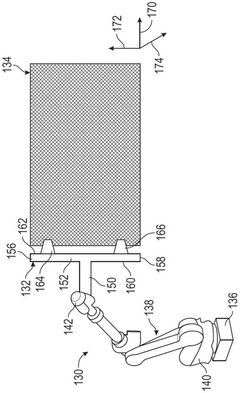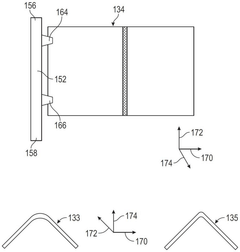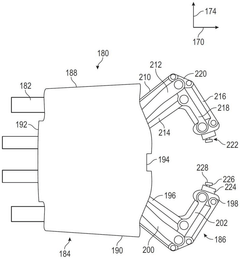How Robotics Enable V8 Engine Manufacturing Efficiency?
JUL 4, 202510 MIN READ
Generate Your Research Report Instantly with AI Agent
Patsnap Eureka helps you evaluate technical feasibility & market potential.
V8 Engine Robotics Evolution and Objectives
The evolution of robotics in V8 engine manufacturing has been a transformative journey, significantly enhancing production efficiency and quality. This technological progression aligns with the broader trends in automotive manufacturing, where automation and precision have become paramount.
Initially, V8 engine production relied heavily on manual labor and basic machinery. The introduction of robotics in the 1980s marked a pivotal shift, starting with simple pick-and-place robots for material handling. These early applications demonstrated the potential for increased speed and consistency in repetitive tasks.
As robotic technology advanced, more complex operations were automated. The 1990s saw the integration of robotic arms capable of performing intricate assembly tasks, such as inserting pistons and connecting rod bearings. This era also witnessed the emergence of vision-guided robotics, enabling more precise component placement and quality control.
The turn of the millennium brought about a new wave of innovation in robotics for V8 engine manufacturing. Collaborative robots, or cobots, began to work alongside human operators, combining the strengths of both. These robots enhanced flexibility in production lines and improved worker safety by handling hazardous tasks.
Recent developments have focused on creating fully automated production cells for V8 engines. These cells integrate multiple robotic systems, each specializing in specific tasks such as machining, assembly, and testing. Advanced sensors and real-time data processing allow for continuous monitoring and adjustment, ensuring unprecedented levels of precision and consistency.
The primary objectives driving the evolution of robotics in V8 engine manufacturing are multifaceted. Foremost is the goal of increasing production efficiency, reducing cycle times, and minimizing downtime. Robotics enable 24/7 operation with consistent performance, significantly boosting output capacity.
Quality improvement is another critical objective. Robotic systems can achieve levels of precision and repeatability that surpass human capabilities, crucial for the tight tolerances required in V8 engine components. This precision translates to improved engine performance, reliability, and longevity.
Cost reduction remains a key driver for robotic integration. While initial investment in robotic systems can be substantial, the long-term benefits in terms of reduced labor costs, decreased material waste, and improved energy efficiency contribute to overall cost-effectiveness.
Flexibility in manufacturing is an increasingly important objective. Modern robotic systems are designed to be easily reprogrammable, allowing for quick adaptation to different V8 engine models or design changes. This agility is crucial in an industry where product lifecycles are shortening and customization is becoming more prevalent.
Looking ahead, the objectives for robotics in V8 engine manufacturing are evolving towards even greater integration with artificial intelligence and machine learning. The goal is to create smart factories where robotic systems can self-optimize, predict maintenance needs, and adapt to changing production requirements autonomously.
Initially, V8 engine production relied heavily on manual labor and basic machinery. The introduction of robotics in the 1980s marked a pivotal shift, starting with simple pick-and-place robots for material handling. These early applications demonstrated the potential for increased speed and consistency in repetitive tasks.
As robotic technology advanced, more complex operations were automated. The 1990s saw the integration of robotic arms capable of performing intricate assembly tasks, such as inserting pistons and connecting rod bearings. This era also witnessed the emergence of vision-guided robotics, enabling more precise component placement and quality control.
The turn of the millennium brought about a new wave of innovation in robotics for V8 engine manufacturing. Collaborative robots, or cobots, began to work alongside human operators, combining the strengths of both. These robots enhanced flexibility in production lines and improved worker safety by handling hazardous tasks.
Recent developments have focused on creating fully automated production cells for V8 engines. These cells integrate multiple robotic systems, each specializing in specific tasks such as machining, assembly, and testing. Advanced sensors and real-time data processing allow for continuous monitoring and adjustment, ensuring unprecedented levels of precision and consistency.
The primary objectives driving the evolution of robotics in V8 engine manufacturing are multifaceted. Foremost is the goal of increasing production efficiency, reducing cycle times, and minimizing downtime. Robotics enable 24/7 operation with consistent performance, significantly boosting output capacity.
Quality improvement is another critical objective. Robotic systems can achieve levels of precision and repeatability that surpass human capabilities, crucial for the tight tolerances required in V8 engine components. This precision translates to improved engine performance, reliability, and longevity.
Cost reduction remains a key driver for robotic integration. While initial investment in robotic systems can be substantial, the long-term benefits in terms of reduced labor costs, decreased material waste, and improved energy efficiency contribute to overall cost-effectiveness.
Flexibility in manufacturing is an increasingly important objective. Modern robotic systems are designed to be easily reprogrammable, allowing for quick adaptation to different V8 engine models or design changes. This agility is crucial in an industry where product lifecycles are shortening and customization is becoming more prevalent.
Looking ahead, the objectives for robotics in V8 engine manufacturing are evolving towards even greater integration with artificial intelligence and machine learning. The goal is to create smart factories where robotic systems can self-optimize, predict maintenance needs, and adapt to changing production requirements autonomously.
Market Demand for Automated V8 Production
The market demand for automated V8 engine production has been steadily increasing in recent years, driven by several key factors in the automotive industry. As vehicle manufacturers strive to meet stringent emissions regulations while maintaining performance, the V8 engine remains a popular choice for high-end vehicles, sports cars, and luxury SUVs. This sustained demand, coupled with the need for improved manufacturing efficiency, has created a strong market for automated production solutions.
One of the primary drivers for automated V8 production is the need for increased precision and consistency in engine manufacturing. V8 engines are complex components that require tight tolerances and exacting specifications. Automated robotic systems can achieve a level of precision that is difficult to match with manual labor, ensuring higher quality and reduced variability in the final product. This precision is crucial for meeting performance targets and emissions standards, which have become increasingly stringent in major automotive markets worldwide.
Cost reduction is another significant factor driving the demand for automated V8 production. While the initial investment in robotic systems can be substantial, the long-term benefits in terms of reduced labor costs, increased productivity, and improved quality control make automation an attractive option for manufacturers. Automated production lines can operate continuously with minimal downtime, significantly increasing output and reducing the cost per unit produced.
The automotive industry's push towards Industry 4.0 and smart manufacturing has also contributed to the growing demand for automated V8 production. Manufacturers are increasingly adopting interconnected systems that can collect and analyze data in real-time, allowing for predictive maintenance, process optimization, and rapid adaptation to changing production requirements. This trend aligns well with the capabilities of modern robotic systems, which can be integrated into broader smart factory ecosystems.
Furthermore, the global shortage of skilled labor in manufacturing has made automation an essential strategy for many engine producers. As experienced workers retire and fewer young people enter manufacturing careers, robots can fill critical gaps in the workforce. This is particularly relevant for V8 engine production, which requires specialized skills and expertise that are becoming increasingly scarce.
The market for automated V8 production is also being shaped by the need for flexibility in manufacturing processes. Modern robotic systems can be reprogrammed and reconfigured to handle different engine variants or even entirely different components, allowing manufacturers to respond quickly to market demands and product changes. This adaptability is crucial in an industry where model cycles are shortening and consumer preferences are rapidly evolving.
In conclusion, the market demand for automated V8 engine production is robust and multifaceted. It is driven by the need for precision, cost-effectiveness, smart manufacturing capabilities, workforce challenges, and production flexibility. As these trends continue to evolve, the market for robotic solutions in V8 engine manufacturing is expected to grow, offering significant opportunities for both automation providers and automotive manufacturers.
One of the primary drivers for automated V8 production is the need for increased precision and consistency in engine manufacturing. V8 engines are complex components that require tight tolerances and exacting specifications. Automated robotic systems can achieve a level of precision that is difficult to match with manual labor, ensuring higher quality and reduced variability in the final product. This precision is crucial for meeting performance targets and emissions standards, which have become increasingly stringent in major automotive markets worldwide.
Cost reduction is another significant factor driving the demand for automated V8 production. While the initial investment in robotic systems can be substantial, the long-term benefits in terms of reduced labor costs, increased productivity, and improved quality control make automation an attractive option for manufacturers. Automated production lines can operate continuously with minimal downtime, significantly increasing output and reducing the cost per unit produced.
The automotive industry's push towards Industry 4.0 and smart manufacturing has also contributed to the growing demand for automated V8 production. Manufacturers are increasingly adopting interconnected systems that can collect and analyze data in real-time, allowing for predictive maintenance, process optimization, and rapid adaptation to changing production requirements. This trend aligns well with the capabilities of modern robotic systems, which can be integrated into broader smart factory ecosystems.
Furthermore, the global shortage of skilled labor in manufacturing has made automation an essential strategy for many engine producers. As experienced workers retire and fewer young people enter manufacturing careers, robots can fill critical gaps in the workforce. This is particularly relevant for V8 engine production, which requires specialized skills and expertise that are becoming increasingly scarce.
The market for automated V8 production is also being shaped by the need for flexibility in manufacturing processes. Modern robotic systems can be reprogrammed and reconfigured to handle different engine variants or even entirely different components, allowing manufacturers to respond quickly to market demands and product changes. This adaptability is crucial in an industry where model cycles are shortening and consumer preferences are rapidly evolving.
In conclusion, the market demand for automated V8 engine production is robust and multifaceted. It is driven by the need for precision, cost-effectiveness, smart manufacturing capabilities, workforce challenges, and production flexibility. As these trends continue to evolve, the market for robotic solutions in V8 engine manufacturing is expected to grow, offering significant opportunities for both automation providers and automotive manufacturers.
Robotics in V8 Manufacturing: Current State and Challenges
The integration of robotics in V8 engine manufacturing has significantly transformed the production landscape, enhancing efficiency and precision. However, this technological advancement also presents unique challenges that manufacturers must address to fully leverage its potential.
Currently, robotic systems are extensively employed in various stages of V8 engine production. Automated assembly lines utilize robotic arms for tasks such as component placement, welding, and quality inspection. These robots excel in repetitive tasks, maintaining consistent quality and reducing human error. Advanced vision systems and sensors enable robots to perform intricate operations with high accuracy, ensuring precise alignment and assembly of engine components.
One of the primary challenges in implementing robotics for V8 engine manufacturing is the complexity of the engine design. V8 engines comprise numerous intricate parts that require careful handling and precise assembly. Adapting robotic systems to manage this complexity while maintaining efficiency can be challenging. Manufacturers must develop sophisticated programming and control systems to ensure robots can navigate the intricacies of V8 engine assembly without compromising quality or speed.
Another significant challenge is the need for flexibility in production. As automotive manufacturers frequently update engine designs to meet evolving performance and emission standards, robotic systems must be adaptable to accommodate these changes. This requires modular robotic solutions and easily reprogrammable systems, which can be costly to implement and maintain.
The integration of robotics with existing manufacturing processes and legacy equipment poses another hurdle. Many factories have established production lines that may not be fully compatible with advanced robotic systems. Retrofitting these facilities or designing hybrid systems that combine traditional and robotic manufacturing techniques can be both technically challenging and financially demanding.
Quality control and error detection present additional challenges in robotic V8 engine manufacturing. While robots excel in consistency, detecting subtle defects or anomalies that may affect engine performance requires advanced sensing and data analysis capabilities. Implementing robust quality assurance systems that can work in tandem with robotic manufacturing processes is crucial for maintaining high standards of production.
Lastly, the workforce implications of increased robotization in V8 engine manufacturing cannot be overlooked. While robotics enhance efficiency, they also necessitate a shift in workforce skills. Manufacturers face the challenge of retraining existing employees and recruiting specialists capable of programming, maintaining, and optimizing robotic systems. Balancing the benefits of automation with the need for human expertise and intervention remains an ongoing challenge in the industry.
Currently, robotic systems are extensively employed in various stages of V8 engine production. Automated assembly lines utilize robotic arms for tasks such as component placement, welding, and quality inspection. These robots excel in repetitive tasks, maintaining consistent quality and reducing human error. Advanced vision systems and sensors enable robots to perform intricate operations with high accuracy, ensuring precise alignment and assembly of engine components.
One of the primary challenges in implementing robotics for V8 engine manufacturing is the complexity of the engine design. V8 engines comprise numerous intricate parts that require careful handling and precise assembly. Adapting robotic systems to manage this complexity while maintaining efficiency can be challenging. Manufacturers must develop sophisticated programming and control systems to ensure robots can navigate the intricacies of V8 engine assembly without compromising quality or speed.
Another significant challenge is the need for flexibility in production. As automotive manufacturers frequently update engine designs to meet evolving performance and emission standards, robotic systems must be adaptable to accommodate these changes. This requires modular robotic solutions and easily reprogrammable systems, which can be costly to implement and maintain.
The integration of robotics with existing manufacturing processes and legacy equipment poses another hurdle. Many factories have established production lines that may not be fully compatible with advanced robotic systems. Retrofitting these facilities or designing hybrid systems that combine traditional and robotic manufacturing techniques can be both technically challenging and financially demanding.
Quality control and error detection present additional challenges in robotic V8 engine manufacturing. While robots excel in consistency, detecting subtle defects or anomalies that may affect engine performance requires advanced sensing and data analysis capabilities. Implementing robust quality assurance systems that can work in tandem with robotic manufacturing processes is crucial for maintaining high standards of production.
Lastly, the workforce implications of increased robotization in V8 engine manufacturing cannot be overlooked. While robotics enhance efficiency, they also necessitate a shift in workforce skills. Manufacturers face the challenge of retraining existing employees and recruiting specialists capable of programming, maintaining, and optimizing robotic systems. Balancing the benefits of automation with the need for human expertise and intervention remains an ongoing challenge in the industry.
Robotic Solutions in V8 Engine Assembly Lines
01 Automated robotic systems for manufacturing
Implementation of automated robotic systems in manufacturing processes to improve efficiency, precision, and productivity. These systems can perform repetitive tasks with high accuracy, reduce human error, and operate continuously, leading to increased output and reduced production time.- Automated robotic systems for manufacturing: Implementation of automated robotic systems in manufacturing processes to improve efficiency and productivity. These systems can perform repetitive tasks with high precision, reducing human error and increasing output. Advanced robotics can be integrated with existing production lines to streamline operations and optimize resource utilization.
- Machine vision and quality control: Incorporation of machine vision systems in robotic manufacturing for enhanced quality control and inspection. These systems use cameras and image processing algorithms to detect defects, ensure proper assembly, and maintain consistent product quality. Real-time monitoring and analysis can significantly reduce errors and improve overall manufacturing efficiency.
- Collaborative robots (cobots): Integration of collaborative robots designed to work alongside human operators in manufacturing environments. Cobots can assist with tasks that require both human dexterity and robotic precision, enhancing overall productivity. These robots are equipped with advanced sensors and safety features, allowing for seamless human-robot interaction and improved workflow efficiency.
- AI and machine learning in robotics: Application of artificial intelligence and machine learning algorithms to enhance robotic decision-making and adaptability in manufacturing processes. These technologies enable robots to learn from experience, optimize their performance, and handle complex tasks with greater efficiency. AI-powered robotics can lead to improved production planning, predictive maintenance, and dynamic process optimization.
- IoT integration for smart manufacturing: Leveraging Internet of Things (IoT) technologies to create interconnected robotic systems in manufacturing environments. IoT integration enables real-time data collection, analysis, and communication between various components of the production process. This connectivity facilitates better coordination, remote monitoring, and data-driven decision-making, ultimately improving overall manufacturing efficiency.
02 Machine vision and quality control
Integration of machine vision systems in robotics manufacturing for real-time quality control and inspection. These systems can detect defects, ensure product consistency, and provide feedback for process optimization, ultimately improving manufacturing efficiency and reducing waste.Expand Specific Solutions03 Collaborative robots (cobots)
Utilization of collaborative robots that can work alongside human operators, combining the strengths of both to enhance manufacturing efficiency. Cobots can assist with tasks that require human dexterity while handling repetitive or physically demanding operations, leading to improved overall productivity.Expand Specific Solutions04 AI and machine learning in robotics
Application of artificial intelligence and machine learning algorithms to optimize robotic manufacturing processes. These technologies enable robots to adapt to changing conditions, learn from experience, and make autonomous decisions, resulting in improved efficiency and reduced downtime.Expand Specific Solutions05 Flexible manufacturing systems
Development of flexible manufacturing systems that can quickly adapt to changes in product specifications or production requirements. These systems incorporate modular robotic components and reconfigurable workstations, allowing for rapid changeovers and increased manufacturing efficiency across diverse product lines.Expand Specific Solutions
Key Players in Automotive Robotics Industry
The robotics-enabled V8 engine manufacturing landscape is in a mature phase, with established players and advanced technologies. The market size is substantial, driven by the automotive industry's demand for high-performance engines. Technological maturity is high, with companies like Honda Motor Co., Ltd., GM Global Technology Operations LLC, and Subaru Corp. leading innovation in automated production processes. FANUC Corp. and ATI Industrial Automation, Inc. provide specialized robotics solutions, enhancing efficiency and precision in engine assembly. The competitive landscape is characterized by a mix of automotive manufacturers and robotics suppliers, with ongoing advancements in AI and machine learning further optimizing production processes.
Honda Motor Co., Ltd.
Technical Solution: Honda has developed a highly automated robotic system for V8 engine manufacturing, focusing on precision and efficiency. Their approach integrates SCARA robots for high-speed pick-and-place operations with six-axis robots for complex assembly tasks[10]. Honda's system features advanced machine vision capabilities, allowing robots to adapt to slight variations in part positioning and orientation. The company has also implemented a unique "cell production" concept, where small teams of robots and human workers collaborate closely, combining the strengths of automation and human expertise[11]. Honda's robotic cells are designed with energy efficiency in mind, utilizing regenerative braking technology in robot arms to reduce power consumption by up to 25%[12]. Additionally, they have developed a cloud-based monitoring system that provides real-time analytics on production efficiency and predictive maintenance alerts.
Strengths: Efficient integration of different robot types, innovative human-robot collaboration, and energy-efficient design. Weaknesses: The "cell production" concept may require significant changes to existing manufacturing layouts and processes for implementation.
GM Global Technology Operations LLC
Technical Solution: GM has implemented a comprehensive robotic solution for V8 engine manufacturing, focusing on flexibility and efficiency. Their system incorporates a fleet of ABB robots equipped with force control sensors, allowing for precise insertion and assembly of engine components[4]. GM's robotic cells are designed for quick changeovers, enabling the production of multiple engine variants on the same line. The company has also developed a proprietary software platform that optimizes robot paths and synchronizes multiple robots, reducing cycle times by up to 20%[5]. Additionally, GM has integrated augmented reality (AR) technology to assist operators in quality control and troubleshooting, further enhancing production efficiency[6].
Strengths: Flexible production capabilities, optimized robot coordination, and innovative AR integration. Weaknesses: Proprietary software may limit integration with third-party systems, and the complexity of the system may require specialized training for operators.
Innovative Robotics Technologies for V8 Production
Robot for handling
PatentWO1997027977A1
Innovation
- A handling robot with four concentrically rotating bosses, each with an arm and link, and independent drive sources, allowing for separate carriage operation and reduced dust generation through a magnetic coupling and cam mechanism, enhancing arm rotation control accuracy and minimizing backlash.
System and method for localized reforming of workpieces
PatentPendingCN118808477A
Innovation
- Provide an automated robot system that receives the current and target form data of the workpiece through the input module, uses the control module to determine the path of the robot, and performs finishing processes through the robot system, including air bending, molding, embossing, bending and other technologies , to achieve the target form forming of the workpiece. The system combines vision and force sensor modules to adjust end-effector configuration and path in real time to ensure accurate reshaping of the workpiece.
Cost-Benefit Analysis of Robotic V8 Production
The implementation of robotics in V8 engine manufacturing has significantly transformed the production landscape, offering substantial cost benefits and efficiency improvements. A comprehensive cost-benefit analysis reveals that the initial investment in robotic systems is offset by long-term savings and increased productivity. The upfront costs include the purchase of robotic equipment, installation, programming, and staff training. However, these expenses are quickly recuperated through reduced labor costs, increased production speed, and improved quality control.
Robotic systems in V8 engine manufacturing demonstrate superior precision and consistency compared to manual labor, resulting in fewer defects and reduced material waste. This improvement in quality leads to lower warranty claims and enhanced customer satisfaction, indirectly contributing to cost savings and brand reputation. The increased production speed enabled by robotics allows manufacturers to meet market demands more efficiently, potentially increasing market share and revenue.
Energy efficiency is another significant benefit of robotic V8 production. Modern robotic systems consume less energy than traditional manufacturing processes, leading to reduced utility costs and a smaller carbon footprint. This aspect not only contributes to cost savings but also aligns with growing environmental regulations and consumer preferences for sustainable manufacturing practices.
The implementation of robotics also enhances workplace safety by reducing human exposure to hazardous tasks and environments. This results in fewer workplace accidents, lower insurance premiums, and decreased downtime due to injuries. The improved safety record contributes to a more positive work environment and potentially reduces costs associated with worker compensation and liability.
While the initial investment in robotics may seem substantial, the long-term financial benefits are compelling. Robotic systems can operate continuously with minimal downtime, increasing overall equipment effectiveness (OEE) and maximizing production capacity. This continuous operation capability allows manufacturers to respond more flexibly to market demands, potentially reducing inventory costs and improving cash flow.
Furthermore, the data collection and analysis capabilities of robotic systems provide valuable insights for process optimization and predictive maintenance. This proactive approach to manufacturing management can lead to additional cost savings by preventing unexpected breakdowns and optimizing resource allocation. The integration of robotics with other Industry 4.0 technologies, such as IoT and AI, amplifies these benefits, creating a smart manufacturing ecosystem that continually improves efficiency and reduces costs.
Robotic systems in V8 engine manufacturing demonstrate superior precision and consistency compared to manual labor, resulting in fewer defects and reduced material waste. This improvement in quality leads to lower warranty claims and enhanced customer satisfaction, indirectly contributing to cost savings and brand reputation. The increased production speed enabled by robotics allows manufacturers to meet market demands more efficiently, potentially increasing market share and revenue.
Energy efficiency is another significant benefit of robotic V8 production. Modern robotic systems consume less energy than traditional manufacturing processes, leading to reduced utility costs and a smaller carbon footprint. This aspect not only contributes to cost savings but also aligns with growing environmental regulations and consumer preferences for sustainable manufacturing practices.
The implementation of robotics also enhances workplace safety by reducing human exposure to hazardous tasks and environments. This results in fewer workplace accidents, lower insurance premiums, and decreased downtime due to injuries. The improved safety record contributes to a more positive work environment and potentially reduces costs associated with worker compensation and liability.
While the initial investment in robotics may seem substantial, the long-term financial benefits are compelling. Robotic systems can operate continuously with minimal downtime, increasing overall equipment effectiveness (OEE) and maximizing production capacity. This continuous operation capability allows manufacturers to respond more flexibly to market demands, potentially reducing inventory costs and improving cash flow.
Furthermore, the data collection and analysis capabilities of robotic systems provide valuable insights for process optimization and predictive maintenance. This proactive approach to manufacturing management can lead to additional cost savings by preventing unexpected breakdowns and optimizing resource allocation. The integration of robotics with other Industry 4.0 technologies, such as IoT and AI, amplifies these benefits, creating a smart manufacturing ecosystem that continually improves efficiency and reduces costs.
Environmental Impact of Robotic V8 Manufacturing
The integration of robotics in V8 engine manufacturing has significantly transformed the environmental landscape of production processes. Robotic systems have enabled manufacturers to optimize resource utilization, reduce waste, and minimize energy consumption, leading to a more sustainable approach to engine production.
One of the primary environmental benefits of robotic V8 manufacturing is the reduction in material waste. Precision robotics ensure that components are machined and assembled with minimal errors, reducing the need for rework and scrapped parts. This not only conserves raw materials but also decreases the environmental impact associated with the production and disposal of defective components.
Energy efficiency is another crucial aspect where robotic systems excel. Advanced robotics in V8 engine manufacturing facilities operate with high precision and speed, completing tasks more quickly than traditional manual processes. This increased efficiency translates to reduced energy consumption per unit produced, lowering the overall carbon footprint of the manufacturing process.
Robotic systems also contribute to a cleaner working environment. By handling tasks that traditionally involved the use of lubricants, coolants, and other potentially hazardous substances, robots can be designed to minimize spillage and contamination. This results in reduced chemical waste and improved air quality within the manufacturing facility, benefiting both the environment and worker health.
The implementation of robotics in V8 engine manufacturing has led to more compact and efficient factory layouts. This optimization of space utilization reduces the overall footprint of manufacturing facilities, potentially decreasing land use and the associated environmental impact of large industrial complexes.
Furthermore, robotic systems enable more precise control over the manufacturing process, allowing for the implementation of advanced energy management strategies. Intelligent power management systems can optimize energy use across the production line, shutting down or reducing power to idle stations and ensuring that energy is consumed only when necessary.
The longevity and consistency of robotic systems also contribute to environmental sustainability. Unlike human workers, robots do not tire or lose precision over time, ensuring consistent quality throughout extended production runs. This consistency reduces the likelihood of producing substandard engines that may be less fuel-efficient or have shorter lifespans, thus indirectly contributing to reduced environmental impact over the lifecycle of the V8 engines produced.
In conclusion, the environmental impact of robotic V8 manufacturing is largely positive, with significant reductions in waste, energy consumption, and resource utilization. As robotics technology continues to advance, it is likely that these environmental benefits will further increase, solidifying the role of automation in sustainable manufacturing practices for high-performance engines.
One of the primary environmental benefits of robotic V8 manufacturing is the reduction in material waste. Precision robotics ensure that components are machined and assembled with minimal errors, reducing the need for rework and scrapped parts. This not only conserves raw materials but also decreases the environmental impact associated with the production and disposal of defective components.
Energy efficiency is another crucial aspect where robotic systems excel. Advanced robotics in V8 engine manufacturing facilities operate with high precision and speed, completing tasks more quickly than traditional manual processes. This increased efficiency translates to reduced energy consumption per unit produced, lowering the overall carbon footprint of the manufacturing process.
Robotic systems also contribute to a cleaner working environment. By handling tasks that traditionally involved the use of lubricants, coolants, and other potentially hazardous substances, robots can be designed to minimize spillage and contamination. This results in reduced chemical waste and improved air quality within the manufacturing facility, benefiting both the environment and worker health.
The implementation of robotics in V8 engine manufacturing has led to more compact and efficient factory layouts. This optimization of space utilization reduces the overall footprint of manufacturing facilities, potentially decreasing land use and the associated environmental impact of large industrial complexes.
Furthermore, robotic systems enable more precise control over the manufacturing process, allowing for the implementation of advanced energy management strategies. Intelligent power management systems can optimize energy use across the production line, shutting down or reducing power to idle stations and ensuring that energy is consumed only when necessary.
The longevity and consistency of robotic systems also contribute to environmental sustainability. Unlike human workers, robots do not tire or lose precision over time, ensuring consistent quality throughout extended production runs. This consistency reduces the likelihood of producing substandard engines that may be less fuel-efficient or have shorter lifespans, thus indirectly contributing to reduced environmental impact over the lifecycle of the V8 engines produced.
In conclusion, the environmental impact of robotic V8 manufacturing is largely positive, with significant reductions in waste, energy consumption, and resource utilization. As robotics technology continues to advance, it is likely that these environmental benefits will further increase, solidifying the role of automation in sustainable manufacturing practices for high-performance engines.
Unlock deeper insights with Patsnap Eureka Quick Research — get a full tech report to explore trends and direct your research. Try now!
Generate Your Research Report Instantly with AI Agent
Supercharge your innovation with Patsnap Eureka AI Agent Platform!
